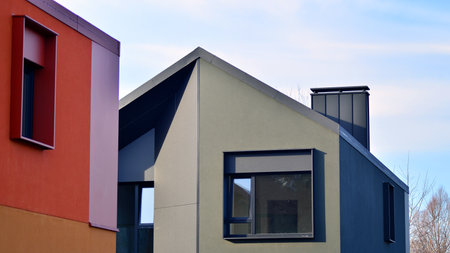Understanding Your Homes Architectural Style
Before you start planning your home addition, it’s essential to understand the architectural style of your existing house. This step will help you create a new space that looks like it’s always been there, instead of sticking out awkwardly. American homes come in many styles, each with unique features. By identifying these key characteristics, you can make sure your addition blends seamlessly with your home’s original design.
Common American Home Styles and Their Key Features
| Style | Main Characteristics |
|---|---|
| Colonial | Symmetrical facade, multi-pane windows, central front door, gabled roof, brick or wood siding |
| Craftsman | Low-pitched rooflines, exposed rafters, wide front porches with thick columns, handcrafted stone or wood details |
| Modern | Clean lines, open floor plans, large windows, flat or low-slope roofs, minimal ornamentation |
| Ranch | Single-story layout, long and low profile, large windows, attached garage, simple open floor plan |
How to Identify Your Home’s Style
- Look at the Roof: Is it steep and gabled (Colonial), low and wide (Ranch), or flat (Modern)?
- Check the Windows: Are they multi-pane (Colonial), big picture windows (Modern), or grouped together under wide eaves (Craftsman)?
- Notice the Front Porch: Craftsman homes usually have deep porches with chunky columns, while Ranch homes may have a small stoop or none at all.
- Examine Exterior Materials: Colonial homes often use brick or wood siding; Modern homes might use stucco or even metal.
Why It Matters
If your addition follows the main elements of your home’s style—like window shape, roofline, and materials—it will feel natural and cohesive. Taking time now to pinpoint these details will save you headaches later and help your project look professionally designed.
2. Collaborating with Local Architects and Designers
When planning a home addition that truly blends in with your existing architecture, working closely with local architects and designers is key. These professionals bring valuable knowledge about the unique characteristics of your region, common building styles in your neighborhood, and the ins and outs of city or HOA regulations. By partnering with experts familiar with local construction trends, you can avoid costly mistakes and ensure your new space feels like it was always part of your home.
Why Choose Local Experts?
Local architects and designers understand the history, materials, and popular styles in your area. They know what’s permitted by city codes and homeowners associations, saving you time and hassle during the approval process. Their expertise also helps make design choices that complement your neighborhood’s look, which can boost your property value and keep neighbors happy.
Benefits of Working with Local Professionals
| Benefit | Description |
|---|---|
| Familiarity with Codes | Ensure your project meets city zoning laws and HOA requirements. |
| Neighborhood Style Matching | Blend new construction seamlessly with surrounding homes. |
| Efficient Permitting Process | Smooth navigation through local permit applications and inspections. |
| Access to Regional Materials | Select materials that are durable for your climate and match existing structures. |
| Problem-Solving Experience | Address challenges unique to your area—like weather or landscape—with proven solutions. |
Tips for Choosing the Right Professional Team
- Check Credentials: Make sure they’re licensed to work in your state and have experience with additions similar to yours.
- Ask About Previous Projects: Request before-and-after photos or references from clients in your neighborhood.
- Review Communication Style: Choose someone who listens to your ideas and explains options clearly.
- Get Everything in Writing: A detailed contract should outline scope, timeline, budget, and responsibilities.
Collaborating with knowledgeable local architects and designers makes it much easier to create an addition that looks original to your home while staying within the rules set by your city or HOA. Their guidance ensures every detail—from rooflines to window trims—fits right in with the rest of your property and community.
![]()
3. Selecting Matching Materials and Finishes
One of the most important steps in designing a seamless home addition is choosing materials and finishes that blend perfectly with your existing house. If you want your new space to look like it’s always been there, pay close attention to both exterior and interior details.
Exterior Materials: Siding, Roofing, Windows, and Trim
Start by taking a close look at your current home’s exterior. Notice the color, texture, and style of your siding or brickwork. Is your roof made of asphalt shingles, clay tiles, or metal? What about your window frames—are they wood, vinyl, or aluminum? These details matter when sourcing new materials for your addition.
| Element | Existing Home | Home Addition (Recommended) |
|---|---|---|
| Siding/Brick | Light gray clapboard | Match with same color & profile clapboard |
| Roofing | Black asphalt shingles | Select identical black asphalt shingles |
| Windows | White double-hung vinyl | Use white double-hung vinyl windows |
| Trim & Details | Crisp white wood trim | Install matching white wood trim |
Tips for Choosing Exterior Materials:
- If your original siding or roofing is discontinued, bring a sample to a local supplier to find the closest match.
- Pay attention to the width and pattern of siding boards or bricks.
- Match window grille patterns and hardware for consistency.
- If repainting is needed, use paint-matching technology at hardware stores for an exact color blend.
Interior Finishes: Flooring, Paint, and Fixtures
The inside of your addition should also flow naturally from the rest of your home. Use similar flooring materials—such as hardwood, tile, or carpet—in consistent colors or stains. Wall paint should be matched closely or complemented with harmonious shades. Light fixtures, door handles, and baseboards should echo the style already present in your house.
Checklist for Interior Consistency:
- Flooring: Match wood species and stain; align tile size and grout color.
- Wall Color: Use leftover paint or color-match at a local store.
- Moldings & Trim: Duplicate profiles and heights for baseboards and crown molding.
- Hardware: Choose finishes (like brushed nickel or oil-rubbed bronze) that are already used in adjacent rooms.
Selecting the right materials is key for making your new addition feel like part of the original house—both inside and out. Take your time comparing samples and don’t hesitate to consult with local suppliers familiar with homes in your area.
4. Maintaining Proportion and Scale
When planning a home addition, keeping the proportions and scale consistent with your existing house is essential for achieving a seamless look. The new space should feel like a natural extension, not something tacked on as an afterthought. Here’s how you can make sure your addition complements the original structure:
Match Size and Height
The size of your addition matters. If its too large or too small compared to your current home, it can throw off the entire appearance. Try to keep the height of the rooflines, ceilings, and floors consistent with those in your original house. This helps everything blend together visually.
| Element | What to Match | Why It Matters |
|---|---|---|
| Ceiling Height | Same as existing rooms | Creates a smooth interior flow |
| Roofline | Align with original roof pitch and shape | Makes exterior look unified from the street |
| Window & Door Sizes | Use similar dimensions and placements | Keeps façade balanced and appealing |
| Room Scale | Avoid oversized or undersized spaces | Maintains comfortable proportions inside |
Keep Layout in Sync with Original House
The layout of your new addition should enhance the existing floor plan rather than disrupt it. For example, align hallways, doorways, and traffic flow so moving between old and new spaces feels natural. Use similar room shapes and avoid odd angles that could make the addition stand out in a negative way.
Tips for Achieving Visual Balance:
- Check that exterior walls line up for a cohesive look.
- If adding a second story, set it back slightly to avoid overwhelming the original structure.
- Repeat design elements like trim, siding patterns, and window grids.
- Consult an architect familiar with homes in your neighborhood for guidance on common styles and proportions.
Curb Appeal Counts!
A well-proportioned addition not only improves daily living but also enhances your homes curb appeal and value. By paying close attention to proportion and scale, you ensure your new space looks like it’s always been part of your home.
5. Blending Interior Spaces and Flow
Why Seamless Interior Integration Matters
When adding onto your home, it’s not just about what’s on the outside. The inside matters just as much! If you want your new space to feel like it truly belongs, you need to pay close attention to how the interiors blend. Everything from the floors beneath your feet to the moldings above your head should feel connected and cohesive.
Matching Key Interior Details
The secret to a seamless addition is matching the small details that make up your home’s character. Here are some of the most important features to focus on:
| Feature | Existing Home | New Addition | Tips for Consistency |
|---|---|---|---|
| Flooring | Hardwood Oak Planks | Install same hardwood and stain color | Source flooring from same supplier if possible; match finish and plank size |
| Moldings & Trim | Classic 4-inch white baseboards | Replicate baseboard style and paint color | Take a sample to your hardware store or millwork shop for a perfect match |
| Wall Color & Texture | Smooth eggshell beige paint | Use identical paint type and color code | Ask your painter to blend new with old for invisible transitions |
| Door Hardware & Styles | Brushed nickel lever handles, panel doors | Select same door models and hardware finishes | Order from same manufacturer if possible for an exact match |
| Lighting Fixtures | Recessed LED in main living spaces | Add matching LED fixtures in addition areas | Stick with similar fixture shapes, materials, and color temperatures (Kelvin) |
Create an Effortless Flow Between Old and New Spaces
A successful home addition should feel like it was always there. To achieve this, consider the flow between rooms. Wide openings, consistent ceiling heights, and aligning sightlines help connect spaces visually and physically. You may also want to use the same style of window treatments or continue built-in shelving into the new area.
Pro Tips for Smooth Transitions:
- Avoid abrupt changes: If the existing hallway is carpeted, don’t switch suddenly to tile—use transition strips or matching carpets.
- Mimic architectural features: Arched doorways or exposed beams? Continue those elements into your addition for instant harmony.
- Create focal points: Align major features like fireplaces or large windows so they draw people naturally from one space to another.
- Keep lighting consistent: Use dimmers or smart lighting systems throughout both old and new spaces for a uniform ambiance.
The Bottom Line: It’s All About Details!
No matter how big or small your home addition is, taking time to match interior finishes ensures that everything feels like one thoughtfully designed home—not two separate spaces awkwardly joined together.


